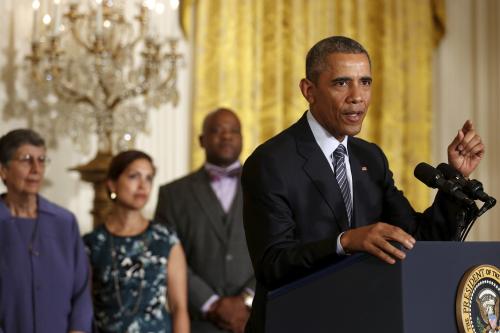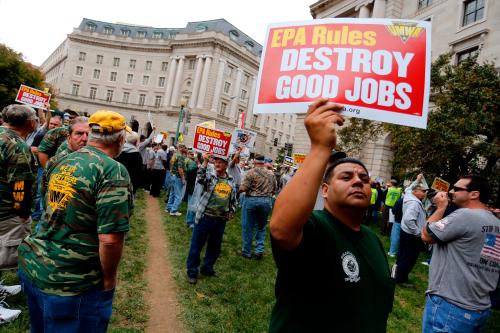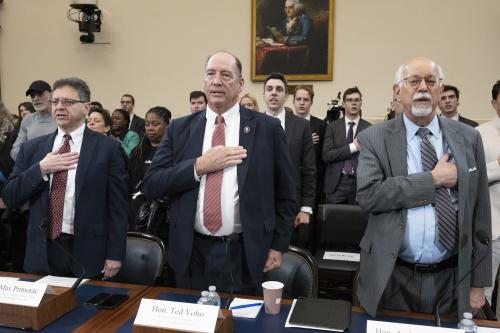Today was the Clean Power Plan’s big day at the Court of Appeals for the D.C. Circuit, which took the extraordinary step of skipping over a 3-judge appellate panel and going right to a full en banc hearing, with 10 judges hearing the case. Challengers of the EPA’s regulation of existing power plants—perhaps the central piece in the Obama administration’s climate change legacy—managed to get the Supreme Court to stay the rule back in February, so for now it sits dormant as its fate is fought out in courts.
From the D.C. Circuit, these proceedings will almost certainly go to the Supreme Court—but the outside chance that we will continue to have an eight-justice court long enough that they could be deadlocked 4-4 means that it is possible that the D.C. Circuit will have the last word. As a result, there was a small army of people at the courthouse doors early this morning waiting to be admitted to hear the oral arguments.
The Clean Power Plan’s challengers have quite a few reasons they believe that the Clean Power Plan should be thrown out: they say it is ruled out by a conflict with another part of the Clean Air Act; that it unconstitutionally commandeers state officials and improperly encroaches on states’ police powers; and that it is procedurally defective in a number of serious ways. It is possible that any of these complaints could succeed in knocking out the rule, but it has always seemed to me that the real question of the case is simpler: does the Clean Power Plan represent a reasonable and permissible interpretation of the Environmental Protection Agency’s authority under § 111(d) of the Clean Air Act, which commands EPA to set standards that represent the “Best System of Emissions Reduction” (BSER) adequately demonstrated to be feasible? I watched the Court spend approximately two hours of oral argument on this question alone (and then skipped out, exhausted, from the arguments over the other questions). The discussion was impressive and far-ranging; I offer a necessarily selective recap and analysis here.
The Challengers, represented by West Virginia Solicitor General Elbert Lin and Peter Keisler of Sidley Austin, argued that the Clean Power Plan is an unprecedented and transformative rule that allows EPA to oversee the “creation of a new energy economy.” In making this case, they cheekily quoted EPA Administrator Gina McCarthy bragging about the rule’s importance—even as EPA’s own lawyers sought to portray it as marked by incrementalism and continuity with past regulations.
The crux of their case is that the BSER standard cannot encompass the range of practices that EPA assumed could be used in calculating it. Coal- and gas-fired power plants are asked to meet a standard that cannot be met simply by making alterations to their on-site operations, effectively requiring plant owners to buy power from newly constructed renewable energy (wind and solar) sources in order to be in compliance with the law. Not only is any one coal plant incapable of complying without “generation-shifting” to renewable energy providers, so is the source category as a whole. That is, all of the country’s coal plants must become dependent on new renewable energy sources if they are to be allowed to continue to operate—if not as a matter of explicit command by EPA, then at least as a de facto function of the situation that EPA will have quite intentionally brought about.
EPA’s rejoinder is that while generation-shifting from fossil-fuel-fired plants to renewables may sound radical, it is in fact the mainstay of various systems of regulatory compliance already in full swing in the power industry today. Some power companies supporting the government in this position, represented by Kevin Poloncarz of Paul Hastings, seemed to catch the judges’ attention. Nothing radical, nor novel, nor certainly unreasonable, to see here, the government and its power company allies assured the judges.
The challengers asked the judges to reject these assurances for three main reasons.
- First, they said, is the “major questions” doctrine most familiar from FDA v. Brown & Williamson Tobacco Corp. (2000). The idea here is that if an executive agency is going to undertake an extremely consequential course of new regulation, the statute it relies upon had better make a very clear statement of Congress’s support for such a path. Major innovations are to be given less deference than minor adjustments, and the EPA’s innovations here don’t have much in the way of clear support. A few judges (Kavanaugh and Millett, notably) seemed fairly concerned by this issue, which could knock out EPA’s legs before ever really getting to the hard statutory interpretation questions. But I have my doubts that it will prove decisive.
- Second, they suggested that the BSER as the EPA defines it is not actually about regulating fossil-fuel-fired generators: it is about allowing EPA to push the costs of having a cleaner energy system to whomever it deems appropriate. Indeed, the standard is a lever for an EPA power-play rather than a genuine effort to define reasonable levels of pollution based on a source category’s characteristics. Notably, the rule’s detractors conceded that the parts of EPA’s calculations based only on in-plant modifications (Building Block 1) are acceptable, but insisted that other parts of the rule effectively assumed they would be “subsidizing their competition” by having to buy power from them. The word “subsidy” was hurled about quite aggressively during this discussion, nor surprisingly carrying rhetorical weight in the context of industry challengers’ attempt to frame the Clean Power Plan as a revival of old-fashioned industrial policy.
- Finally, they made a number of narrow but apparently strong textual points about the EPA’s power under § 111(d) relative to other portions of the Clean Air Act. Notably, they argued that while other portions of the Act might admit an emissions credit trading scheme by offering language of “other methods, means, and techniques” of pollution reduction, § 111(d) lacks such a phrase and thus limits what EPA can shoehorn into BSER.
EPA’s rebuttals, conveyed mainly by the Department of Justice’s Eric Hostetler, insisted that the agency is entitled to expansive Chevron deference in figuring out what BSER can mean. The major questions doctrine applies only to whether EPA has the authority—which in this case it clearly does—and has little to say about how it exercises it. The idea that plants must be regulated while their owners, who are usually diversified energy conglomerates operating many types of generators, should be left entirely out the equation is a kind of “make-believe” with no reasonable basis in the statutory text.
During Hostetler’s colloquy with the judges, there was one of the most exciting exchanges I’ve ever had a chance to witness in a courtroom. Judge Tatel asked Hostetler to respond directly to the petitioners’ question of whether requiring generation-shifting was a qualitatively new sort of regulation for EPA to undertake. Of course he denied it, but he found himself on his heels as Judges Brown, Kavanaugh, and Griffith pushed him to dwell on the constitutional significance of the case for the separation of powers. Griffith brought up the way President Obama has pointed to the Clean Power Plan as his way of circumventing a resistant Congress. Kavanaugh, especially, sought to make himself Congress’s advocate in this discussion: he said that it didn’t matter if there was understandable frustration with congressional torpor, big decisions must nevertheless be left to the first branch, the only one capable of balancing interests and forging all-things-considered compromises. He said that he had no doubt EPA found its own decisions reasonable, but doubted whether unelected bureaucrats or judges ought to be making decisions which will clearly leave so many people, especially from coal country, as losers.
Hostetler seemed more than a little flummoxed by these critiques—at times he was nearly yelling at the judges—and at one point he made a remarkable admission: nothing in the nature of BSER itself would prevent EPA from requiring zero emissions. EPA was constrained from that only because doing so would not be feasible given available technologies and current costs. To my mind, if EPA should win, that would make § 111(d) an extraordinarily flexible and powerful tool for it in future decades—the agency could comfortably ratchet up carbon emissions controls to deliver a zero-carbon economy as long as they could make the case that doing so was just a matter of adopting one cost-feasible, reliability-consistent, incremental step after another. Hostetler concluded his comments with a rousing invocation of the Supreme Court’s two greenhouse gas cases, Massachusetts v. EPA (2007) and AEP v. Connecticut (2011), and told the judges that they would be making a mockery of these landmarks if they failed to uphold the Clean Power Plan.
Many observers assume that this case is so important that it will come down to the judges siding with their political loyalties. That may well be the most likely outcome, in which case 6 Democratic appointees (Rogers, Tatel, Srinivasan, Millett, Pillard, and Wilkins) will outvote 4 Republican ones (Henderson, Brown, Griffith, and Kavanaugh). From what I saw today, though, that doesn’t seem like an entirely foregone conclusion. Judges Millett and Srinivasan, and sometimes Judge Tatel, asked the government hard questions that suggested they were uncomfortable with various aspects of the rule. In any case, this case gives the capable D.C. Circuit judges even more of an opportunity than usual to act the part of a sub-supreme court, and we can expect their opinions in a few months to provide a telling look at how the three branches are likely to relate to each other in coming years.
The Brookings Institution is committed to quality, independence, and impact.
We are supported by a diverse array of funders. In line with our values and policies, each Brookings publication represents the sole views of its author(s).






Commentary
The D.C. Circuit considers the Clean Power Plan, and our constitutional future
September 27, 2016